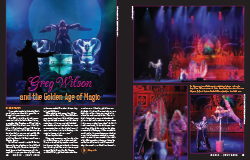Description
The Wonderful Wizard of Oslo
By Inge Groote
Floating balls, dancing neckties, smoke-filled soap bubbles, and other animated objects have helped make Finn Jon’s reputation as an innovative illusionist for the past half century. Finn Jon is a creative conjuror unlike any other, onstage and off.
Greg Wilson and the Golden Age of Magic
By Chris Philpott
When Disney Studios planned to showcase their latest film, Maleficent, at the El Capitan Theatre in Hollywood with a live magic show, they turned to Greg Wilson. The result is an elaborate production of classic magic in tribute to bygone days.
Happy Campers
By Ryan Oakes
Comparisons to Harry Potter are easy thanks to the gothic look of the campus, but Tannen’s Magic Camp predates Hogwarts by a quarter century. This year marks the fortieth anniversary of Tannen’s Magic Camp, a summer adventure of workshops, performances, and enduring friendships, all centered around magic.
Fred Becker: Doing Gigs on Ships
By Rory Johnston
From the moment he learned it was possible to do magic on board cruise ships, Fred Becker knew that was what he was destined to do. Still continuing his career on both land and sea, Becker has been instructing others on cruise performing, a work environment like no other.
Plus Updates on…
MAGIC Update
- Flash paper fire at Hey Presto Magic in Sydney, Australia
- The 105th Annual Salute to Magic in New York
- The second annual Beyond Brookledge event
- A look at upcoming magic on TV and in the movies
- Remembrances of Mike Abston and Bob Bluemle
Bonus Content for the July Issue…
Now Playing on M360
- Two Finn Jon montages, showing excerpts from his performances and clips from his lectures.
- A trailer for Greg Wilson’s The Golden Age of Magic show at the El Capitan Theatre in Hollywood.
- The five-minute opening of Magic Camp, the documentary shot at Tannen’s Magic Camp in 2008.
- Convention Podcasts: MagiCelebration, and Abbott Magic Get-together.
Market place
Product Reviews
Fifteen products are reviewed this month by Peter Duffie, Gabe Fajuri, Jared Brandon Kopf, Bryce Kuhlman, Francis Menotti:
Ridiculous by David Williamson
The Streets by John Archer
Stephen Hobbs’ Technical Toolbox by Stephen Hobbs
The Last Prediction by Kneill X
The Mobius Coin Wallet by Anthony Miller (RFA Productions)
The Truth From a Liar by Hannibal
E2 by Peter Nardi and Rob Bromley
Suitcase Tables from Showtime Magic Products
Card Cube by Persus Arkomanis
Silent Treatment Digital Edition by Jon Allen
The History of Conjuring and Magic by Henry Ridgley Evans
Another: At The Fingertips Series #1 by Dr. Mutobe
Risk 4 by Rizki Nanda
Smudged by John Horn
The REL Change by Michael Brewer
The Monk’s Way
The Monk’s Way
Steve Reynolds
A Bluffer Cuts to the Aces
There are some performers who imagine a layperson viewing a trick like a magician. This is not so. (And your wife is not a layperson!) So, let me give you some hints on how to look at a trick from a layperson’s point of view. Let’s also answer an important question that will be a guiding factor as we continue to delve into « The Monk’s Way » in upcoming articles: When does the effect begin? To do this, I’ll deconstruct an effect.
First Look
Norman Gilbreath
Beyond Imagination
Norman Gilbreath is best known for the mathematical principle that bears his name. This month, « First Look » presents Polarized Colors, an effect excerpted from Norman’s new book, Beyond Imagination. The book includes the math that explains the basis for some of the tricks and routines that are described in the text. Norman notes, « For those who find mathematics a foreign language, not to worry — you can skip all the text concerning the reasons why things work and the magic will still work, if you are careful. None of the magic has been left to chance. »
Loving Mentalism
Ian Rowland
Quincidence
This month’s guest contributor is Blair Franklyn from New Zealand. Blair has devised a very neat routine featuring two spectators, five coins, and a series of choices — which coins they place in their pockets, which one they give to you, and whether they toss heads or tails. Surprisingly, you are able to predict every detail correctly, including the results of two coin tosses. What makes this even more impressive is that all of the coins involved are imaginary. That’s right, all these choices take place in the imaginations of the two spectators. The only things that are real are your written predictions, which are 100 percent correct. It’s a neat, baffling mystery that you can perform at a moment’s notice.
Bent on Deception
Mike Bent
Stationary(ery) Walk-Around Magic
In the mid ’90s, I was hired by Staples to perform at a vendor fair where they were showing off new items to clients. When I got there, I was handed a big cardboard case full of Post-It Notes. I couldn’t figure out why they wanted me to push Post-Its, which had been out for years, but it wasn’t an issue. In the middle of a trick, I reached for the pad to write something down, and the whole stack lifted up accordion-style in my hand. It was like a Post-It Note Electric Deck gag. This surprised me and the crowd, and the silliness of it got a good laugh. It turns out I was given a brand-new product that was just being introduced: Post-It Pop Up Notes. The second I saw these, a perfect trick came to mind. I quickly assembled it and then performed it all day. It got a great reaction every time. It also got everyone playing with and talking about the product, which made the person in charge happy. I call it Post-itive Identification.
Classic Correspondence
Mike Caveney
Lloyd Jones to Dave Fiscus (Part 1)
This letter is incredible on a variety of levels. First is its length, a whopping five typed pages, so rich in content that it will be necessary to serialize it over three months. Equally amazing is how this letter found its way to Egyptian Hall. For that, I must thank Dave Fiscus, a faithful reader of this column who received this letter as a young man, 56 years ago. When he stumbled upon it last year, he wondered if I might like to add it to the files of Egyptian Hall Museum. It wasn’t until it arrived in the mail that I realized what a gold mine I have been given. The letter represented a master’s thesis on the state of the magic world in America during the middle of the 20th century.
For What It’s Worth
Mark Kornhauser
Maskelyne, and Kornhauser: The « A » Word
It’s been more than 100 years since Nevil Maskelyne and David Devant published Our Magic. In 1911, they thought that magic had advanced quite a lot. The average magician was « educated in a public school » and had gained some social status — « public school » in the UK being the same as « private school » in the US. They predicted that, one day, magic would be considered a fine art. How is that working out?
Walkabout Soup
Simon Coronel
Walkabout Soup Performance Enhancing Drugs II: A Completely True Yet Misleading Statement
Anyone with a Facebook or Twitter account knows the pleasure that comes from making a really clever status update. One that still makes me smile happened back in 2009, when I was preparing for what was, at the time, the biggest gig of my career.





